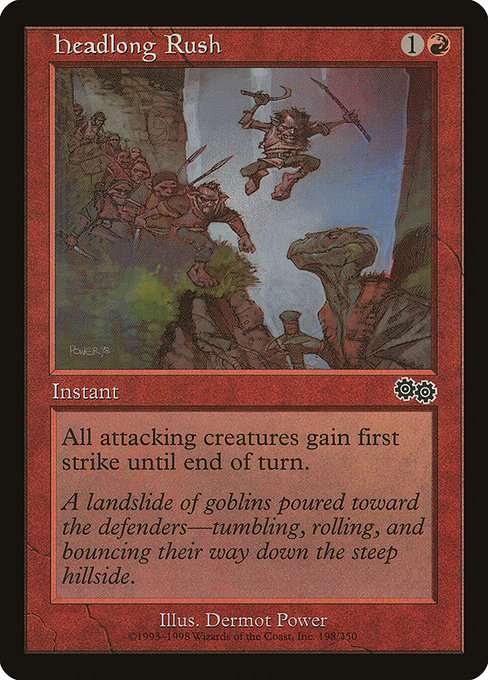
Image courtesy of Scryfall.com
Headlong Rush: Reimagining Red's Swift Strike in MTG Art
In the sprawling tapestry of Magic: The Gathering, red instant spells often function as quick, brutal punctuations in a game that loves tempo. Headlong Rush is a neat example: for the modest investment of one colorless and one red mana (that’s {1}{R}), you hand your creatures a sudden edge by granting first strike until end of turn. The card, a humble common from Urza’s Saga released in 1998, is a reminder that utility and drama can ride on a simple stroke of a painter’s brush and a clever bit of mathematics. 🧙♂️🔥💎
From a gameplay lens, the spell’s text—“Attacking creatures gain first strike until end of turn.”—is a compact statement of control, tempo, and bluff. When your attackers leap forward with first strike, they answer bigger creatures first, tilting combat in your favor and often turning a marginal exchange into a decisive blow. It’s a quintessential red move: risk a little mana to tilt the odds in your opponent’s next moment of decision. The card’s CMC 2 and single—color identity red—keep it accessible in casual and cube formats, where players savor those woolly moments that hinge on a single initiative shift. 🎲⚔️
Art as a conversation: Dermot Power’s Urza’s Saga vision and fan reinterpretations
The original illustration by Dermot Power puts a kinetic stamp on a goblin-laden hillside, a moment of chaos erupting with the inevitability of a landslide. The flavor text—A landslide of goblins poured toward the defenders—tumbling, rolling, and bouncing their way down the steep hillside.—evokes a vivid, almost kinetic scene where whimsy and danger collide. It’s a classic example of MTG art that doesn’t just depict a spell; it sets a mood: red is not only about speed and flame, but also about the exuberant, unpredictable charge of a goblin host. 🧙♂️🎨
“A goblin torrent, a hillside in motion, and a moment where the tide of battle can turn in a single spark of initiative.”
Fans have long taken that spark and translated it into reinterpretations across styles and media. In the fan art ecosystem, Headlong Rush becomes a lens through which artists test color theory, motion, and the bluster of goblin energy. Some reimagine the hillside as a cliffside battleground with extra goblin silhouettes scattering in the wind; others push the moment forward, showing attackers in mid-leap, steel teeth bared, armor rusting under red glare. The common rarity of the card doesn’t deter bold reimaginings; in fact, it invites playful reinterpretations that honor the original while exploring new aesthetics. 💎🔥
What makes fan tributes sing in this mana-driven moment
- Motion and momentum: In art, as in combat, sequence matters. Reinterpretations tend to emphasize the instant when initiative flips—goblins tumbling down, swords flashing, banners snapping in a gust of wind. The result is a dynamic narrative you can feel on the page or screen. 🎨
- Color storytelling: The red mana in Headlong Rush invites fiery palettes—crimson skies, molten earth tones, and pop contrasts that push depth and intensity. Fans often exaggerate heat maps or glow effects to underline why the rush matters. 🧙♂️
- Texture and atmosphere: Some interpretations lean into the gritty, furrowed ground of a hillside; others go glossy and magical, as if the spell itself is a living gust of wind. The art becomes a laboratory for materials—stone, leather, metal—and the tactile feel of a moment that is both violent and playful. 🎲
Even though Urza’s Saga sits firmly in the late 1990s, the fan community of MTG remains forever young at heart, continually remixing iconic frames into fresh compasses for our modern games. The sense of re-interpretation is part of the card’s lasting legacy: a single instant that can be revisited, repainted, and reimagined without ever losing its core bite. 🔥
From tabletop tricks to gallery walls: weaving Headlong Rush into strategy and style
For players, Headlong Rush isn’t just a one-off combat trick; it’s a doorway to tempo plays. In formats that tolerate the card’s legalities—like Legacy and Duel formats—the spell contributes to aggressive or tempo-oriented builds where every swing must be answered. It shines alongside other red tools that reward attacking momentum, and it plays nicely with the broader red philosophy of speed, risk, and direct pressure on the opponent. The art itself becomes a reminder of that philosophy: sometimes a rush is less about picking a fight and more about deciding when to sprint into danger and claim the initiative. ⚔️🎲
Collectors and historians also savor the card for its Urza’s Saga provenance—the expansion that championed the power of artifact enhancements and long, winding flavor narratives. While Headlong Rush remains a straightforward common, its place in the saga’s tapestry is a wink to where MTG started exploring the interplay of speed and consequence in combat, a theme that still resonates in fan art today. 💎
Bringing the theme home: a small promo nudge with a desk companion
As you dive into the swirl of goblin charges and blazing red spells, you might also be curating your desk setup for long creative sessions or tournament prep. A tiny, tactile companion can elevate your work as much as a well-timed attack can swing a game. If you’re in the mood for a practical accessory that keeps you comfy while you draft or stream, consider a practical desk upgrade: a foot-shaped ergonomic memory foam wrist rest mouse pad that supports long sessions without cramping. It’s a nod to the same careful attention to detail that MTG artists put into every frame of a card. 🧙♂️🔥